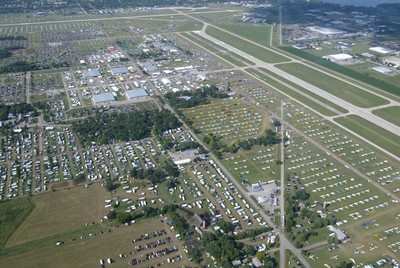Flying Into EAA AirVenture At Wittman Regional Airport Requires Tuned Up Pilot Skills
For a recreational flyer, flying into Wittman Regional Airport during EAA AirVenture is part of the adventure. You’ll probably hear some wild stories about the arrival and departure procedures but if you are prepared it’s a lot of fun. However, you need to be a proficient pilot.

The Safety Speech:
I’ll list some maneuvers you can practice to help get ready for the busy traffic flow at AirVenture. But first, the safety message; don’t practice flight maneuver you are not comfortable with without the help of an experienced safety pilot or flight instructor. Start practicing traffic pattern procedures away from the airport over an open area. Pretend your make-believe airport is 1,000 feet above the actual terrain you are over (also known as a “hard-floor”). Fly your practice pattern altitude above the hard-floor altitude. When you feel good about the practice procedures, you can move them back to your airport.
Speed Control, Level And Descending:
The two speeds we’ll talk about are cruise speed and approach speed. At AirVenture, you may have to change from one speed to the other a couple of times for traffic spacing.
The slowest speed to use is determined by taking the stall speed in landing configuration (Vso) and increasing it by 30%; I’ll call this approach speed. A multiengine airplane may have speed limits determined by engine out performance. If you’re in the pattern with faster planes, you may want to hold cruise speed as long as possible before slowing. Practice this by holding an altitude and changing from cruise to approach speed and back again until you can do it quickly while maintaining altitude. Develop pitch and power settings that will quickly establish speed while holding altitude.
Speed changes may also be required when descending on final approach. Practice this by setting up a simulated final approach to a landing target (remember the hard-floor) and change speed while maintain your descent angle to the target. Slowing to approach speed while descending is tough to do. Get a feel for how long this takes. You’ll want your final approach stabilized at normal approach speed about 500 feet above the ground.
Spot Landings:
At AirVenture it’s common to land two airplanes on the same runway, at the same time by designating landing spots. The runways at Wittman field will have large colored “dots” to designate landing points. Be ready for this by practicing spot landing. Pick a practice airport with an adequately long runway and practice lading at a point well beyond the designated threshold. When doing this, make a normal descent angle to the spot; don’t aim at the normal threshold and then “drag” your plane to the spot. Be safe when you practice. Don’t land so far down a runway that you can’t safely stop. If things don’t look right, go around.
Go-arounds:
Get up-to-date on your go-around skills. We do it so rarely that the real thing may get you flustered. This maneuver can be practiced over an open field using the hard-floor I mentioned earlier. Establish a set procedure for a go-around.
Left Or Right Patterns—Long Or Short Finals:
Most runways use left turns in the traffic pattern. If you are not practicing right patterns in your everyday flying, do it before you go to AirVenture. At AirVenture, you may have to make a tight short approach or a long dragged-out final approach. Practice these variations at your local airport.
You don’t need to be a super pilot to fly into AirVenture Wittman regional Airport but you do need to be proficient, and you can fix that with practice and/or training before you go.
(Image from file)
 ANN's Daily Aero-Term (05.10.24): Takeoff Roll
ANN's Daily Aero-Term (05.10.24): Takeoff Roll Aero-News: Quote of the Day (05.10.24)
Aero-News: Quote of the Day (05.10.24) Airborne 05.06.24: Gone West-Dick Rutan, ICON BK Update, SpaceX EVA Suit
Airborne 05.06.24: Gone West-Dick Rutan, ICON BK Update, SpaceX EVA Suit Airborne 05.03.24: Advanced Powerplant Solutions, PRA Runway Woes, Drone Racing
Airborne 05.03.24: Advanced Powerplant Solutions, PRA Runway Woes, Drone Racing Aero-News: Quote of the Day (05.11.24)
Aero-News: Quote of the Day (05.11.24)



